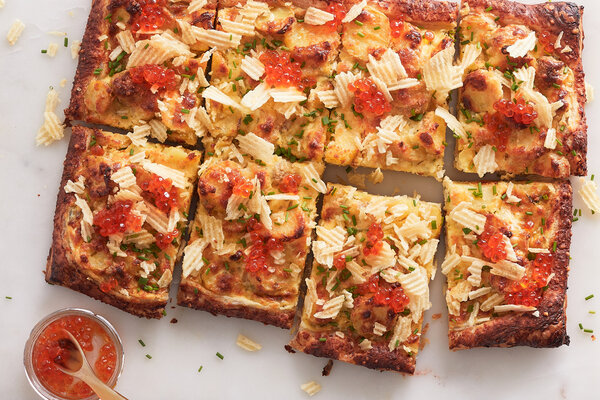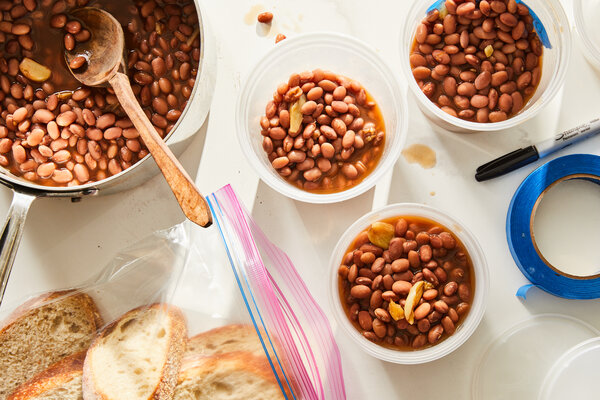The new season of “The Bear” is coming soon, and one memorable scene from the last season starts with the chef Sydney Adamu, played by Ayo Edebiri, cracking a few eggs into a bowl. She then enters the meditative bliss that is making a perfect omelet. Watching her nudge the golden disk over and around a line of creamy cheese brings to mind the sandwich scene from the 2004 movie “Spanglish,” where Adam Sandler, playing a chef alone in his home kitchen after a long night at the restaurant, slides a fried egg over bacon and tomatoes shingled on a thick slice of toast.
What they have in common is how well they capture the culinary ecstasy of making dishes best prepared as single servings in the quiet of the kitchen. In those moments, all of your senses are attuned to creating this small, simple, beautiful thing.
It works only when cooking for one.
This isn’t to say that’s what the experience is always like. If you’ve been cooking for only yourself for years, you’ve already lived this reality. But if you’re new to it, on your own after crowded college dorms or packed family homes, know that preparing single-serving meals can feel more challenging than cooking for a crew.
Klancy Miller celebrated the joys of cooking for one in her 2016 book “Cooking Solo: The Fun of Cooking for Yourself,” but at a certain point during the pandemic, she burned out in the kitchen and turned to takeout.
“Eventually, I kind of did get back to cooking for myself,” she said, “but in a much more basic way.” She still believes in “going all out for yourself,” but now prioritizes figuring out how to simplify dishes to make regularly.
The key to cooking well for one is choosing the right recipes. These tips will help you navigate what will work for you:
Figure out what you like.
It may seem obvious, but there’s a lot of noise on social media to try, say, eating only meat or surviving on snacks. If you examine what you truly want — and then stock those ingredients — you may be less tempted to order in.
“When you think about what you eat over the course of a week, what do you enjoy?” Ms. Miller suggested asking yourself, “And what are the very easy things?”
That second question is critical: Whatever you make should be worth its cost in time, energy and dollars. If you’re craving fries or a complex fine-dining dish, you’re better off going out. The recipes that make the most sense are streamlined, even if they’re as fancy as steak or scallops.
For simple daily sustenance, consider how many times a week you’d be happy having the same dish. Oatmeal for breakfast all week? Quesadillas for dinner once? And maybe once more if stuffed with mushrooms?
Stock up where you can, and relish smaller trips to the store otherwise.
Build a shopping list based on the above, then choose the right quantity of each item. Unless you already make yourself three meals a day or know that you will, stick to buying smaller amounts of groceries, especially fresh items. If you still end up with food on the verge of spoiling, cook it right away to extend its life and avoid having to waste it. (Even lettuce can be stir-fried!)
Larger packages of food generally cost less per ounce, so it’s worth getting them if you can. Pantry staples like pasta, rice, canned goods, spices and vinegars last, as do freezer foods like shrimp and peas, so you can get those in bulk. And if you know you want yogurt every morning, go for the big tub instead of the small cups.
Making multiple grocery runs a week for perishables doesn’t have to feel like a chore. Ms. Miller views going to the grocery store as “Yay! I got out, and it’s the excuse I need to get out of the house.” She buys meat and produce, including herbs, which can give life to pantry ingredients like grains. In this tuna salad, the tinned fish tastes fresher with cucumber and dill and is a great over salad greens for a fast, light meal.
Rethink “meal prep.”
It’s hard to know what that term even means, but it sounds like an obligation more stressful than making a meal start-to-finish — or ordering delivery. To set yourself up to cook without the anxiety of planning, make dishes that can stretch across multiple meals.
One option you may already be practicing is preparing recipes for four or more servings when you have time. But if you know you’ll be bored of the same thing by Day 3, portion and pack the dish into individual servings to freeze.
If you’re not into big-batch cooking, throw together easy recipes that can be enjoyed just once more in a different dish. Instead of a whole chicken, buy a half bird to get white and dark meat without having to eat it all week. In this curry roasted chicken recipe, you can simmer leftovers with coconut milk for a stew or chop everything up to mix with mayonnaise for chicken salad sandwiches.
Make the great meals that are meant for one.
Ms. Miller finds that she now cooks the most ambitiously and creatively when hosting dinner parties, but she is returning to doing the same for herself too.
“I believe fundamentally that you should be just as generous to yourself as you are to others,” she said. “You are worth the extravagance. You deserve nice things too, like a really lavish breakfast.”
A hot sandwich with a runny egg ranks high in this category. Eating one right after it’s stacked ensures that the cheese stays melty, the egg oozy and the bread toasty-crisp yet soft. This meeting of egg-in-a-hole and grilled cheese stretches the delight as a fork-and-knife meal to eat leisurely with a cup of coffee. With a cold beer, it’s just as satisfying at dinner. It captures the spirit Henry David Thoreau describes in the opening line of his chapter on solitude in “Walden”: “This is a delicious evening, when the whole body is one sense, and imbibes delight through every pore.”
Cooking for one may seem like a chore, but when you make yourself meals you love, it’s also deeply gratifying.







